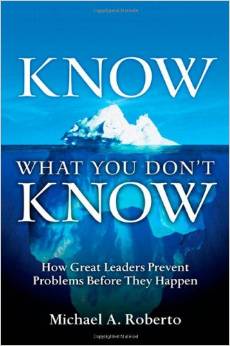Title: Know what you don’t know: How Great Leaders Prevent Problems Before They Happen
Authors: Michael A Roberto
ISBN: 978-0131568150

This book was reviewed by David Evans of Burn Bridge Associates.
Decision-making, problem-solving and creative thinking are significant and current challenges in management practice and so Roberto’s book has some apparent relevance. Sub-titled “How Great Leaders prevent problems before they happen”, this is a book that blends structure with case studies in an easy-read style.
In order to draw the reader in, Roberto explains how organisational breakdowns and crises form from a number of small problems; how often-unrelated issues collide to bring about a unique set of corrosive circumstances. He furthermore points to a common leadership imperative not to be confronted by surprises: leaders prefer the ‘bad news’ upfront. Roberto argues that the most effective leaders are those that seek out the issues before they spiral out of control. This book, then, is about how leaders can develop an acute sense of interrogation. And, it deals with how we should develop a perception of problems as lessons for future improvement. This last message is somewhat counter-cultural: after all, we know that leaders generally dislike the “bad news” story and dirty linen is best aired behind closed doors in the corporate world.
The author’s early pages raise an interesting point about some of our corporate behaviours. In particular, Roberto asks about why data are collected and what happens in terms of analysis and resulting actions. The point he’s making is that much of the effort goes into the collection rather than the analysis of information that might provide real insight and problem-solving capability.
The body of the book focusses on the techniques that leaders should use to become problem solvers. The author devotes a chapter to each of these, for which I provide a short summary below.
Roberto argues strongly that leaders should ‘circumvent the gatekeepers’, since they often hear ‘filtered’ messages from within their organisation; because they are perceived to be too busy – or too senior – to hear the unreconstructed information. He sees it as really important for leaders to get experiences at first hand, to challenge robustly the information they receive and to seek a variety of voices to inform decision-making. He uses several good examples of how this helps to shape issues, with one particularly striking example of a senior GE executive forming a shadow board of young recruits to challenge business strategy.
The author recommends that good leaders have developed a sharp sense of observation and challenge, having become – in effect – an ethnographer. He provides a useful checklist for effective observation (p.65) and urges the practice of triangulation. In this chapter he also describes the dangers of questioning bias, groupthink and cultural bias.
Being inquisitive and observant helps to ‘tune in’ to one’s intuition. Doing this enables a greater ability to seek patterns that might elude us. Roberto uses some good examples from the medical world to demonstrate how decisions are made even when the evidence for such decisions is oblique or thin. Echoing the System 1 thinking described by Daniel Kahneman he also refers to unconscious thinking and provides seven key questions for scrutinising our assumptions.
Roberto develops a detailed picture for the run-up to the tragic events of 09-11 to demonstrate how information is only of use if it is properly disseminated and acted upon. The challenge for leaders is therefore to ensure that their organisation is information-enabled or operating in a silo-based manner. Doing this enables people to ‘connect the dots’. Integrative thinking skills and information-flow are functions of the organisational culture.
The author urges leaders to encourage useful failures. As in many business situations, success comes from trial and error; allowable and manageable failure should be built into the organisational DNA so that colleagues act as openly, expansively and objectively as possible. In this way, information flows more freely, patterns can be discerned and problems anticipated or minimised. Roberto’s’ useful Failure Assessment framework (fig 6.1) highlights how simply this can be done.
A focus on good communications at the heart of a problem-solving culture is good practice. Furthermore, good leaders reflect systematically on their organisation’s conduct and performance in order to learn from within and engender a continuous-improvement ethos. In summary, the characteristics required to develop great problem-solving are summarised by Roberto as being intellectual curiosity, systemic thinking and healthy paranoia.
This is an easy book to read: it starts by defining the concept of problem-finding and then devotes a chapter to each of the seven skills that Roberto has identified as necessary for effective problem-solving. Each chapter is supported with case studies and end-notes. I found some of the examples repeated somewhat and not always entirely apposite. Additionally, the closing chapter, about problem-finding mindset, emphasises how individualistic the skill is: it leads me to conclude that an assessment that identifies personal tenacity, curiosity and openness to new ideas would be a useful starting point when seeking new leaders in your organisation.
Reviewer’s rating: 3 out of 5






